With an increase in Zoom fatigue, it’s easy to wonder, is this all there is?
You may also feel inclined to stick to the virtual team-building activities you have, while silently worrying about their diminishing effectiveness.
And when you look for more ideas among the hundreds of virtual team-building suggestions available, some come across as lame while others are too complicated to be fun.
However, it’s no longer about finding more virtual team-building activities for your distributed team to take part in.
It is about injecting some fun and excitement into the virtual team-building activities you already have.
Here’s how other startups approach their virtual team-building activities.
1. Quizzes
Quizzes come in handy when you want to move beyond awkward small talk, break the ice, and help new team members blend in with everyone else.
This is exactly what Chris Lewandowski from Princess Dental Staffing does for their team-building activities.
“The questions range from fun to serious. Usually, a distributed team manager uses team-building quizzes to identify their team’s conflict resolution abilities and interpersonal style,’’ he explains.
Here are some of the questions the team uses that you can use to help you get started:
- Describe a teammate without revealing their name and let others guess.
- Whose family dinner would you like to crash?
- What’s your go-to remote work outfit?
And if you’re looking for the serious stuff, ask members about their goals, successes, and failures, such as:
- Tell us about a time you failed. What lessons did you learn?
- Who influences your approach toward work?
- What advice would you give to someone starting out in your position?
He goes on to add, ‘’In turn, the activity helps group members brush off their communication and collaboration skills and become better acquainted, fostering group bonds. My go-to app for this type of group activity is Kahoot!’’
A pleasant twist to such quizzes is using the answers you get to build a user manual for each team member.
In the manual, include details on their circadian rhythm, such as their routine, most productive hours, and when they take a break.
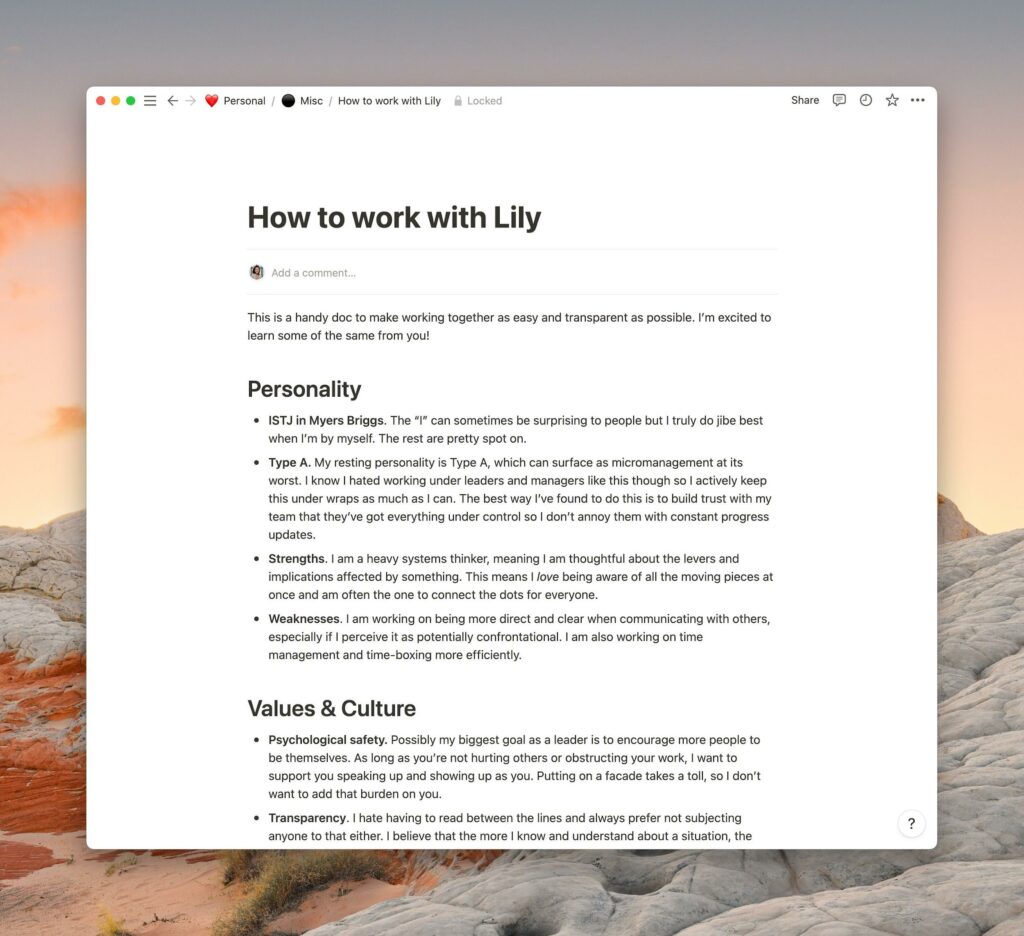
Such details help everyone know when it’s best to contact each other and set the correct internal expectations around communication.
2. Monthly Trivias
Closely related to quizzes are monthly trivias. They are ideal for teams that can make time once or twice a month to unwind and catch up.
Shayla Price, the founder of PrimoStats, describes how they run their monthly trivias, an activity that her team enjoys: “We use Kahoot! to set up an online trivia about pop culture and split into teams to add some friendly competition. It’s a relaxing break from work and an effective way to bring team members together.”
If you’ve been hosting monthly trivias and you’re running out of ideas on what to ask during your next trivia, take a cue from Michael Alexis, CEO of TeamBuilding. He runs cultural-themed trivias with the team and he explains how they do it:
“We run these internal events for Black History Month, Women’s History Month, Pride, and more. Each session is one hour and includes a variety of trivia formats that focus on the theme.
At the end of the event, the winning team selects a charity aligned with the theme and the company makes a $50/person donation to it. This format is a win-win for virtual team-building because it raises team spirits and helps give back to the community as well.’’
Friendly competition improves camaraderie and your employees’ desire to succeed as a team.
3. Video chats
Video chats don’t require a ton of effort or prior preparation. However, it’s easy to avoid them when you run out of things to share midway.
Besides, the resulting awkward silence makes everyone uncomfortable.
So, how do you keep the conversation going?
Iliya Valchanov, the co-founder of 3veta, shares, “The key to having productive and engaging video calls is to make them as interactive as possible. Turning on your camera, asking questions, creating polls, and sharing your screen are just a few techniques to grab your team member’s attention. Furthermore, we at 3veta love to use reactions to express our feelings on the topic. Often there are tons of emojis and claps that not only break the silence but drive the discussion further.”
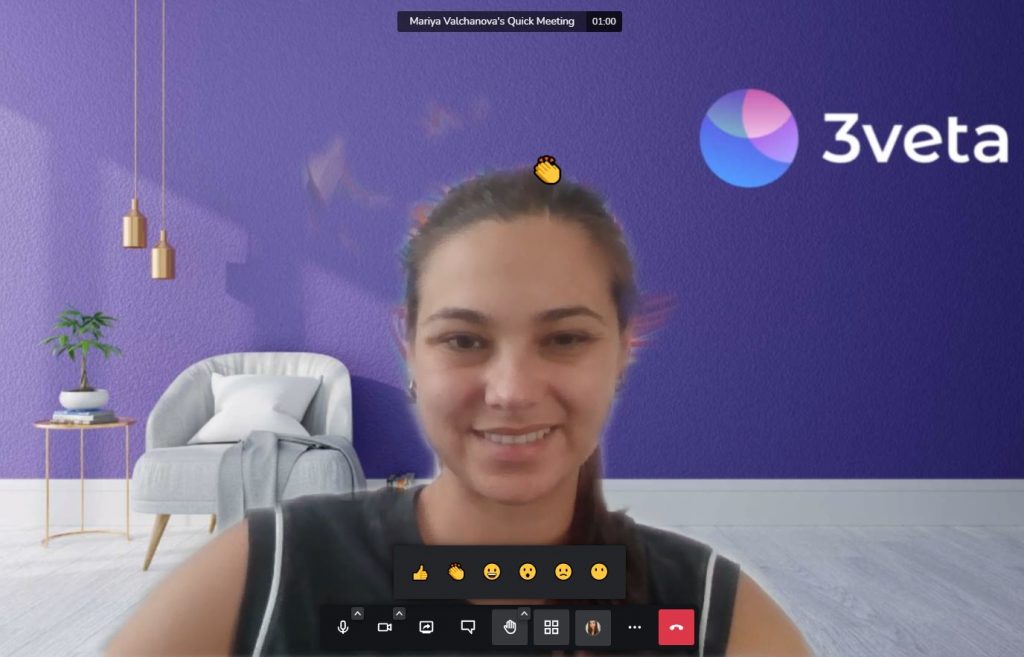
Sam Speller, the founder of Kenko Matcha, explains, “As a remote leader, I’ve organized a few virtual events in the past, including a video chat where we talked about our favorite movies and what they meant to us as individuals. It was a lot of fun, and it gave us an opportunity to learn more about each other’s personalities.’’
As a follow-up activity, team members can have a movie night, or watch a movie that captures everyone’s interest.
Another addition to this would be having a list of movie recommendations and a short blurb about each movie.
Team members can go in and pick a movie to watch and have something to share during the next video chat.
Siobhan Hayes, the director of marketing at Float, has an interesting approach to video chats.
Each month, they match team members at random for a 15-minute chat via Zoom.
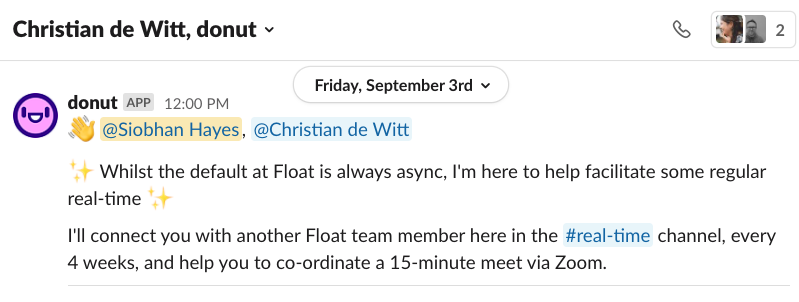
She goes on to explain the rationale behind her approach: “When your entire team works remotely, we don’t get the same opportunities for hallway run-ins or coffee break chats. We use a tool called Donut, which integrates with Slack, to connect us at random with another member of the Float team for a 1:1 meet. Each meeting is scheduled for 15 minutes, and we’re prompted for a new donut date each month.”
With more than 28 team members in more than 14 countries, what’s the likelihood of running out of things to say, knowing that you’ll be speaking to a different team member each month?
💡Pro tip
Remote and hybrid teams have been transitioning to modern video chat solutions. While a video call itself is sufficient on Zoom, a remote team also requires effective scheduling and transparency across the whole team.
4. Virtual lunch hangouts
Virtual lunch hangouts are another way to help expose team members to different types of meals as well as an opportunity to learn about different cultures and how they eat.
If you’re wondering how to go about this, Omer Usanmaz, CEO and Co-Founder of Qooper Mentoring & Learning Software, offers some insights:
“You might pay for this as a company or get the team members to prepare their own meals and show up with them for lunch. It could be a once or twice-a-month event where the company treats the employees to lunch, while they all hop into one online conference room like a Zoom or an MS teams call to hang out. It’s a team-building activity that doesn’t require much effort, but can make a big difference in employee morale.’’

During virtual lunch hangouts, there’s a likelihood of having awkward silences where everyone is focused on their own meal.
Logan Mallory, VP at Motivosity, argues that you don’t have to have a meal together in silence and leave afterward. Here’s how they make their virtual lunch fun and exciting through a virtual potluck:
“Each employee shares details about a recipe that is meaningful to them – perhaps it is a recipe passed down from generations or simply their child’s favorite meal. It is a great way for employees to learn more about each other and connect on a deeper, more personal level. This helps to foster a sense of belonging through an increased personal connection. Not to mention, we all now have a great new repertoire of recipes to try!’’
5. Dedicated channels on Slack
Different time zones mean that you will have everyone on board once or twice a month for a virtual team-building activity.
However, team-building activities don’t have to be synchronous.
In between your monthly team-building activity, keep your team engaged through regular check-ins via Slack.
Lisa Richards, CEO & Creator of the Candida Diet has this to say about regular check-ins:
“One of my favorite team-building activities that I initiated is our whole team taking a few minutes every couple of days to share what each of us is grateful for. We have a ‘Grateful’ board/channel on our remote communication platform where each of us gets to write a statement on what they are thankful for on that specific day. We usually do this every Tuesday and Friday evening. I find that this activity helps us remain grounded, and enables all of us to stay focused on what’s important in life. It also reminds us why we’re working so hard! Moreover, it’s a great way for us to form deeper connections with each other, which makes it easier for us to collaborate effectively, and motivate each other.’’
Asking team members to share what they were up to over the weekend can become monotonous.
Kane Jamison from Content Harmony uses a different approach, and he explains, “every Monday at 8:00 a.m. we automatically post a thread into Basecamp or Slack that asks “What was the highlight of your weekend?”. Everyone on the team is encouraged to share a photo or snippet about what they did. It sounds like a little thing, but it’s a great replacement for the Monday morning ‘how was your weekend’ conversations that used to happen in the office, and after a month or two the team comes to expect it as a way they start off their week.’’
Other dedicated channels you can have are such as a pets channel or a dad jokes channel, to break the monotony of the watercooler channel.
6. Giving gifts
Gift giving is an old tradition that your team can do once or twice a year.
When doing it for the Christmas holidays, create a Google document where each team member anonymously writes a letter to Santa.
The letter should have a wish list of a gift they’d like to have that goes for $50 dollars or less and their shipping details and information.

Once you have this wish list ready, share it with the team to pick a gift they want to buy for a fellow team member.
After everyone gets their gift, have a call with all team members and let everyone open their gifts before you all break for the holidays.
7. Teach what you know
Virtual team-building activities aren’t restricted to non-work-related activities only.
If you’re looking for a way to cross-train your team on different skills, here’s how you can approach it.
Ask your team members to identify a skill that would be relevant to them, e.g. video editing.
Whichever skill they identify, it should be one that they are willing to learn together and that will improve their performance at work.
Once you identify the skill, break it down into different parts and assign these parts to each team member to learn and then come back and teach the rest.
For example, with video editing, you can assign different team members to learn how to use different video editing tools such as Adobe Premiere, Final Cut Pro, and DaVinci Resolve.
The objective here is to learn how to create video clips, snippets, and edit video footage from scratch using each of these tools and share what they learned.
For example, which tool has better features than the rest when it comes to editing video footage? Which tool is easier to use when making video clips and snippets?
That way, you’ll even find it easier to choose the video editing tool to add to your tech stack to help with editing footage for your video marketing campaigns.
8. Virtual Coworking
Virtual coworking is another way to bring the team together, especially team members in the same department, but working remotely in the same time zone.
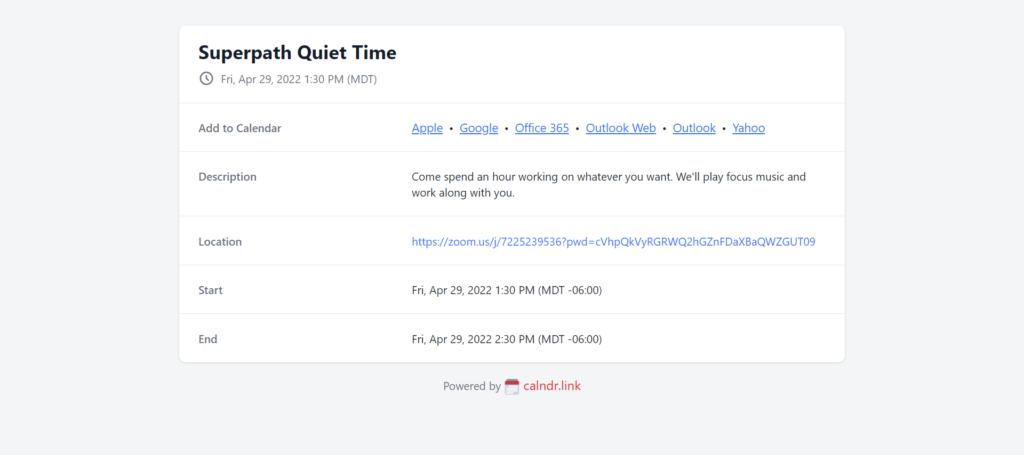
This way, remote work doesn’t feel as isolated, and if there’s a project you’re working on together, virtual coworking helps you stay connected and improves morale, making it easier to hit your KPIs.
9. Virtual Escape Rooms
Remote work can be isolating and your team members might feel trapped within the confines of working every day in their home office or coffee shop. The energy build-up needs a safe release to avoid burnout.
So, after hosting regular sessions co-working virtually, a nice way to switch things up would be to hop onto a virtual escape room once or twice a month to unwind.
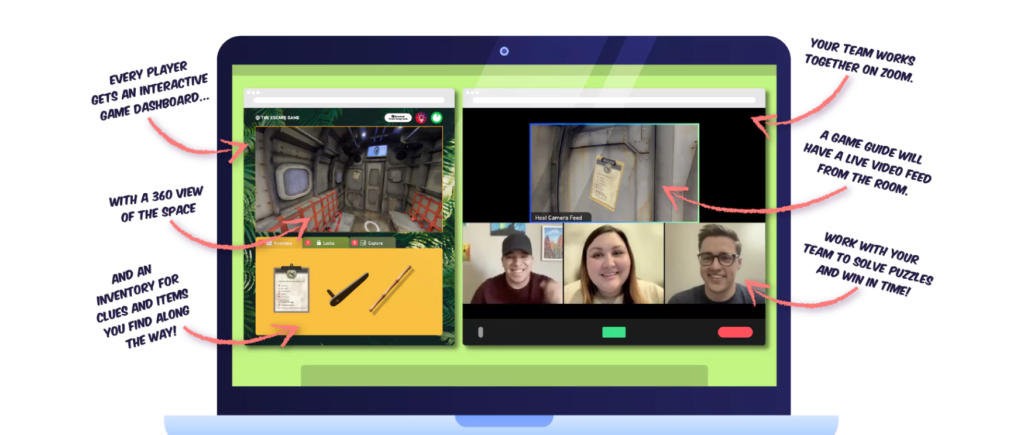
To get some relief from the isolation that comes with remote work, get your team members to start off with a game like Prison Break in your next virtual escape room.
On Prison Break, you’re serving a sentence for a crime you didn’t commit, and now, there’s an opportunity to escape. Your escape window is one hour and you must get out without being caught.
To succeed, you’ll need to cooperate with your virtual teammates, trust them, and communicate effectively.
Another interesting game is Playground. Here, you’ll have to travel back to fifth grade to complete several assignments. You’ll miss your summer holiday if you don’t score a straight A on your assignment.
Conclusion
Whichever virtual or corporate team-building activities you’ve been running with your team, things are likely to get boring when you do the same thing over and over again.
And when you feel like you’ve hit a plateau, take a moment and look for ways to improve what you’re already doing.
Furthermore, there are plenty of team-building apps and tools to help you make work more fun.

Shadrack Wanjohi
Shadrack Wanjohi is a B2B writer who creates content for B2B brands in the Tech and Marketing industry.
